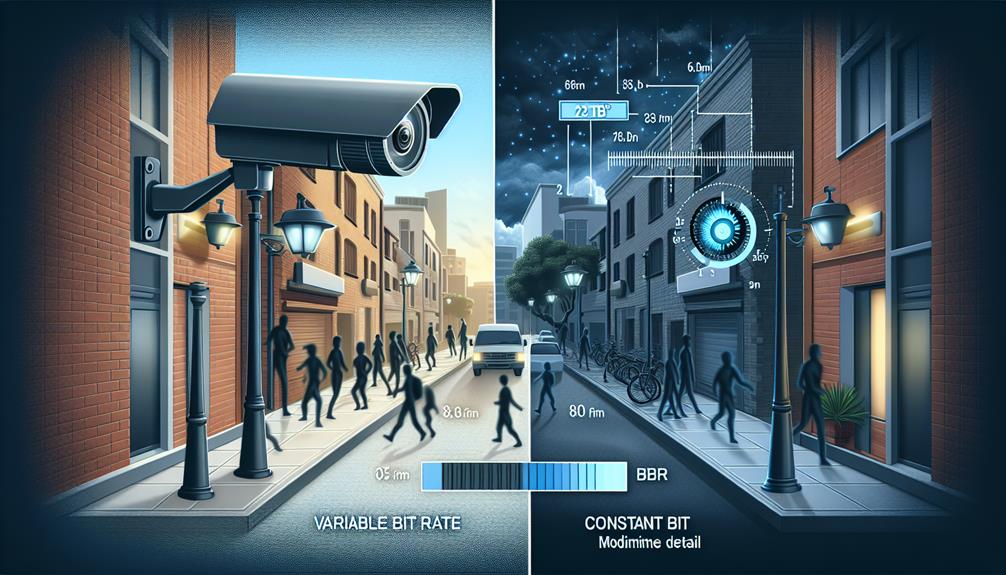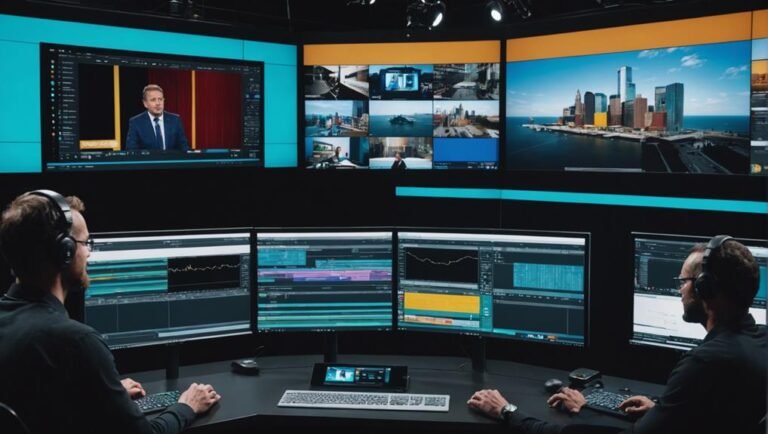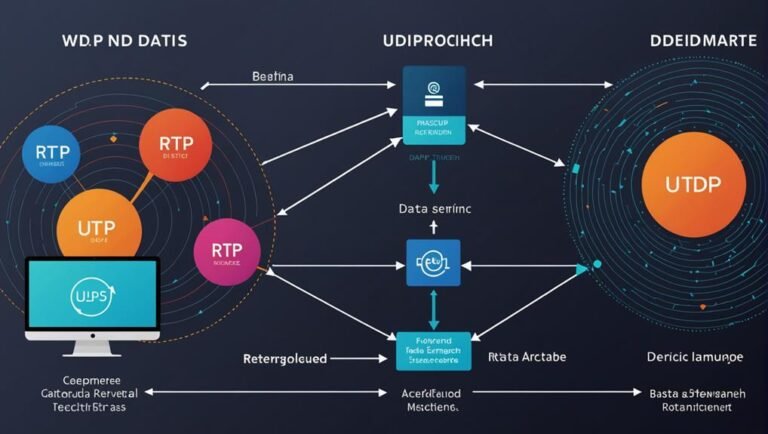In CCTV systems, VBR (Variable Bit Rate) adjusts data based on scene complexity, offering flexibility and better storage efficiency. This means it allocates more bandwidth to complex scenes and uses less for static images, ensuring high-quality footage while saving space. On the other hand, CBR (Constant Bit Rate) maintains a steady bit rate, providing consistent video quality and predictable storage needs, making it ideal for real-time monitoring. VBR is great for environments with fluctuating activity like parks and airports, while CBR suits scenarios requiring stable connections. Want to make the best choice for your CCTV setup?
Understanding VBR
VBR, or Variable Bit Rate, adjusts the amount of data used for video recording based on the complexity of the scene. When you’re looking for flexibility and efficiency in your CCTV system, VBR is a game-changer. It dynamically allocates more data to complex scenes with lots of movement and less data to simpler scenes. This means you won’t waste storage space on static images while ensuring high-quality footage when it counts.
Choosing VBR gives you the freedom to prioritize what’s important. You won’t be locked into a fixed amount of data per second, which can lead to either wasted storage or compromised video quality. Instead, VBR adapts on the fly, making it perfect for environments where scene complexity varies. Imagine capturing a bustling street one moment and a quiet hallway the next—VBR handles both seamlessly.
To make the most of VBR, you’ll need a system that supports it, but the benefits far outweigh the initial setup. You get better storage efficiency without sacrificing video quality. When you’re focused on freedom and flexibility, VBR provides a smart, adaptable solution for your CCTV needs.
Understanding CBR
CBR, or Constant Bit Rate, guarantees a consistent amount of data is used for video recording, regardless of scene complexity. When you choose CBR for your CCTV system, you’re opting for predictability in storage and bandwidth usage. This means you can plan your storage needs more accurately and avoid unexpected spikes in data usage.
Here’s why CBR might be the right choice for you:
- Predictable Storage Needs: With CBR, you’ll know exactly how much data your recordings will use, making it easier to manage storage.
- Stable Network Performance: Since CBR uses a fixed amount of bandwidth, your network won’t suffer from sudden spikes, ensuring smoother operation.
- Simplified System Design: You don’t need to account for variable data rates, simplifying the setup and maintenance of your CCTV system.
- Consistent Video Quality: Even though the scene complexity changes, the bit rate remains constant, providing a uniform quality level.
Quality Comparison
When comparing video quality, the choice between Variable Bit Rate (VBR) and Constant Bit Rate (CBR) can greatly impact the clarity and overall performance of your CCTV footage. Choosing VBR gives you flexibility. It adjusts the bit rate based on the complexity of the scene, ensuring that high-motion areas get the detail they need. This means you’ll capture crisp and clear images when it matters most, like during fast movements or in busy environments.
On the other hand, CBR maintains a steady bit rate, which can be advantageous if you need consistent file sizes and network performance. However, this can sometimes compromise image quality in dynamic scenes, as the bit rate doesn’t adapt to the scene complexity. If you’re in a high-security area where every detail is essential, VBR might be your best bet to make sure no important detail is lost.
You have the freedom to decide based on your specific needs. If you prioritize image quality and can handle variable storage demands, VBR is likely your go-to. If simplicity and consistency are your main goals, CBR offers a straightforward solution.
Storage Efficiency
When it comes to image quality, considering how each bit rate affects storage efficiency is equally important. You want the best footage without eating up your entire storage space, right? Here’s how VBR (Variable Bit Rate) and CBR (Constant Bit Rate) stack up regarding storage efficiency:
- VBR Saves Space: VBR adjusts the bit rate based on the complexity of the scene. This means less storage is used for simpler scenes, freeing up space for more critical footage. You get high-quality images without wasting storage.
- CBR Is Predictable: With CBR, you know exactly how much storage you’ll need because the bit rate remains constant. This predictability can be useful for planning and budgeting storage solutions, though it might not be as efficient.
- Quality vs. Space Trade-off: VBR typically offers better storage efficiency while maintaining quality. However, if you’re okay with a bit more storage use for consistent quality, CBR might be your go-to.
- Storage Costs: Using VBR can lower your storage costs since it optimizes space usage. You’ll need less storage infrastructure, which can be a big win financially.
Best Use Cases
Understanding the best use cases for VBR and CBR in CCTV systems can help you make an informed decision based on your specific needs. When freedom and flexibility are your priorities, knowing when to choose Variable Bit Rate (VBR) or Constant Bit Rate (CBR) is essential.
VBR is ideal if you’re aiming for higher video quality while optimizing storage. It adjusts the bit rate according to the scene’s complexity, giving you sharper images when you need them most. Use VBR for environments with fluctuating activity levels, like parks, airports, or shopping malls. You’ll benefit from efficient storage use during low-activity periods and high-quality footage when things get busy.
On the other hand, CBR is your go-to when you require consistent streaming and predictable storage use. It’s perfect for real-time monitoring scenarios where network bandwidth limitations are a concern, such as remote surveillance or locations with unstable internet connections. CBR ensures your video streams smoothly, avoiding any hiccups that could compromise your security.
Frequently Asked Questions
How Do External Factors Affect VBR and CBR Performance in CCTV Systems?
Imagine your CCTV system as a chameleon adapting to its environment. External factors like network congestion and weather can impact performance. With VBR, you get flexibility, while CBR offers consistency, each responding differently to these influences.
What Are the Typical Maintenance Requirements for VBR and CBR Setups?
You’ll need to regularly check and update firmware, clean cameras, and monitor system performance. With both setups, guarantee peak network health and storage capacity to keep everything running smoothly. Don’t let maintenance bog down your freedom.
Are There Any Security Risks Associated With Using VBR or Cbr?
Yes, there are security risks. Hackers could exploit vulnerabilities in your system, potentially accessing sensitive data. Regular updates and strong encryption help mitigate these risks, so stay vigilant and proactive to protect your freedom.
How Does VBR Impact the Network Bandwidth Compared to Cbr?
You won’t believe how VBR can liberate your network! Unlike CBR’s rigid demands, VBR dynamically adjusts, giving you bursts of bandwidth savings and ensuring smoother, more efficient streaming. It’s like unlocking the wild side of your network!
Can VBR and CBR Settings Be Adjusted Remotely in CCTV Systems?
Yes, you can adjust VBR and CBR settings remotely in most modern CCTV systems. This gives you the freedom to optimize your network bandwidth and storage without being physically present at the site.



